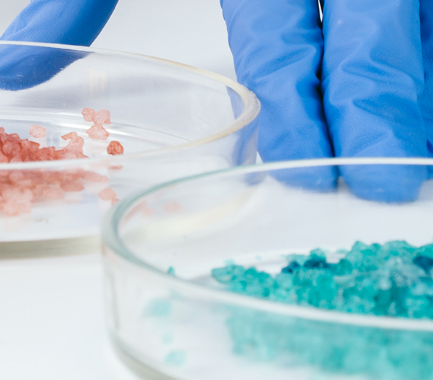Your contact
PENPET-Team - Hamburg

Tim Meister
Sales
Tel. +49 (0) 40 - 675 7 99 40
sales@penpet.de
Get in touch with us.
Phthalic anhydride (PA)
Phthalic anhydride (PA) is one of the aromatic carboxylic acid anhydrides and is an important raw material for processes in the chemical industry. The simplest way to produce the substance is the thermal dehydration of phthalic acid. On an industrial scale, however, the compound is mainly obtained by catalytic gas-phase oxidation of o-xylene in tube bundle reactors. An alternative process is the catalytic oxidation of naphthalene, but this is gradually losing its significance when compared to the process mentioned above.
As a chemical raw material, phthalic anhydride is used in numerous areas of application. The esters of phthalic acid, which serve as plasticizers for polyvinyl chloride (PVC) and other plastics, are of great importance. Phthalic anhydride is also required as an intermediate in the manufacture of many polyester resins, alkyd resins, polyimides, and heterocyclic compounds. Saccharin, isatoic anhydride, phenolphthalein and functionalized aromatics can also be obtained on the basis of the substance. In addition, phthalic anhydride serves as a crosslinking comonomer for epoxy resins and in the production of paints, varnishes, printing inks, coatings, fuel additives and photographic materials. For the pharmaceutical industry, the compound is important as a starting material for the excipient cellulose acetate phthalate.
At PENPET you can easily order the required amount of phthalic anhydride (PSA). We look forward to receiving your inquiry for an individual offer. The solids can be delivered in 25 kg sacks and in Big Bags weighing 500 kg.
CAS no. 85-44-9
EINECS no. 201-607-5
Molecular formula: C8H4O3
Synonyms: Phthalic Anhydride, 2-Benzofuran-1,3-dione, Benzene-1,2-dicarboxylic Anhydride, 1,3-Isobenzofuranedione, 1,3-dioxophthalone, 1,3-dioxo-phthalone, Phthalic Anhydrides, PSA
Areas of application: Starting material for the production of plasticizers, coatings, paints, varnishes, printing inks, photographic materials, pharmaceutical carriers and fuel additives, intermediate for the production of saccharin, phenolphthalein, alkyd resins, polyester resins, polyimides and other compounds
More Information
Phthalic anhydride (PSA) is an organic compound composed of a phenyl group and two dehydrated carboxylic acid groups. The latter are attached to two adjacent carbon atoms of the phenyl ring and linked to one another by a common oxygen atom. This part of the phthalic anhydride therefore represents a second cyclic structure in addition to the phenyl ring.
The substance has aromatic properties and reactive sites for addition processes due to the unsaturated character of the phenyl radical. As a carboxylic acid anhydride, the compound also tends to rehydrate. As soon as it comes into contact with the humidity in the air, parts of the substance gradually convert to phthalic acid. The two compounds can be separated again by distillation.
Phthalic anhydride (PSA) is an aromatic-smelling solid in the form of white to colorless crystalline needles that melts at a temperature of 131 °C and changes to the gaseous state at 285 °C. The compound is only slightly soluble in water, diethyl ether and ethanol. On the other hand, it is easily soluble in other organic solvents such as benzene, acetone, esters and halogenated hydrocarbons. In aqueous solution, the compound hydrolyzes to phthalic acid.
Phthalic anhydride (PSA) is chemically stable in its pure form and when stored dry and airtight. However, there is a risk of explosion in contact with oxidizing agents, glycerin, nitric acid, sodium nitrite, copper oxide. The compound can also react violently and dangerously with alcohols, metals, bases and hot water.
Phthalic anhydride is a combustible substance, but it is difficult to ignite. However, the fine dusts of the compound can form explosive mixtures with the surrounding air if they are whirled up in significant quantities. Phthalic anhydride should therefore be kept away from hot surfaces, sparks, open flames, electrostatic charges and other sources of ignition. When handling the connection, attention should also be paid to minimizing the formation of dust. In the event of a fire or thermal decomposition of phthalic anhydride, large quantities of hazardous and health-endangering substances such as carbon dioxide and carbon monoxide are formed.
Phthalic anhydride (PSA) poses acute and chronic health hazards. The fumes and dusts from the compound are irritating to the eyes and respiratory tract. Direct contact with the substance can cause burns to the cornea and impaired vision. As a result, persistent conjunctivitis can occur. In the event of exposure, the eyes should be rinsed thoroughly with water and then treated by an ophthalmologist. Inhaling phthalic anhydride causes sneezing, coughing, increased mucus secretion and burning pain in the nose, throat and oral mucosa. Asthmatic and allergic reactions are possible.
As an aqueous solution or in combination with moisture, the substance irritates the skin and can cause severe burns in large quantities. Affected body areas should be rinsed thoroughly under running water and cleaned with soap. A medical assessment of possible skin damage is recommended. If swallowed, there is a risk of chemical burns to the mucous membranes and perforation of the esophagus and stomach. Although the systemic toxicity of phthalic anhydride can be assessed as low according to tolerability studies on animals, kidney damage cannot be ruled out after ingestion of significant amounts.
Phthalic anhydride is considered to be slightly hazardous to water due to possible damage to aquatic organisms. The penetration of larger quantities of the compound into the ground, the sewage system or open water must therefore be avoided and the responsible authorities reported in the event of an incident. The transport of the substance is subject to official regulations.
